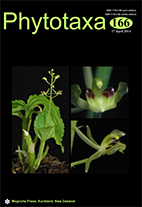Abstract
Two individuals morphologically intermediate between Centaurea horrida Badarò (1824: 367) and C. filiformis Viviani (1825: 6) were collected by Charles Immanuel Forsyth Major on 26 May 1885 at Tavolara Islet, Italy (FI!): these samples were published by Fiori (1904) and later reported in Arrigoni (1972) as two different hybrids: “C. superfiliformis × horrida Levier” and “C. superhorrida × filiformis Levier”. As annotated on the label by Emile Levier, the material deposited in FI shows that the morphology of the two hybrids is very different and only the one named by Fiori as “C. superfiliformis × horrida Levier” was labelled as C. forsythiana Levier (Fig. 1). This sample is morphologically similar to the individuals of a hybrid population we discovered in the same site in the Tavolara Islet (Timone), on limestone, as reported by Fiori (1904). The hybrid named “C. superhorrida × filiformis Levier” by Fiori (1904) was collected by Forsyth Major in a different site (Bocchetta) on granite, and has never been recollected afterwards. For the matter of this note, this is not a problem since, according to Article H.4.1 of the International Code of Nomenclature (McNeill et al. 2012), all the hybrid variants originated from the same parental species, as far as considered nothotaxa (Art. H.3.1), should bear the same name.

